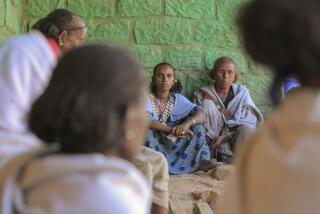Earthwatch: A Diary of the Planet
- Share via
Mongolian Winter Disaster
At least 1.5 million head of livestock have been killed and
Mongolia’s human population faces famine becasue of the country’s most severe winter in 30 years. Raging snowstorms and a deep freeze on the heels of a drought have left thousands of people facing extreme shortages of food. Nomadic groups also are running short of the dried animal dung that serves as fuel to heat their circular tent-like homes against the country’s bitter winter cold. Temperatures across the country have plunged as low as 56 degrees below zero Fahrenheit, and snow has buried the grasses herds live on. The situation is expected to worsen by the end of this month when most winter food supplies will be depleted. The disaster has been intensified by the impact of last summer’s drought, which limited the production of hay normally used to feed animals during the winter months.
*
Killing Drought
More than 20 Kenyans in the drought-ravaged Wajir District have died of starvation during the past two weeks. Two million others are facing famine, and thousands of farm animals have already died in a devastating dry spell that has persisted for three months. Farmers reported that 10,000 cattle, 25,000 camels and 20,000 goats have starved to death. The drought is especially severe in the northern regions of the country.
*
Earthquakes
A magnitude 5.2 earthquake struck southern parts of Indonesia’s Sumatra Island, damaging numerous buildings and homes in the province of Aceh.
* Houses collapsed and other buildings developed cracks when a half-minute temblor struck south of the Indian city of Bombay.
* A magnitude 4.7 earthquake rattled central Italy, cracking ancient churches and damaging homes in communities surrounding Rome.
* Tremors of undetermined magnitude continued to rattle southwest Nigeria, an area that does not have a history of seismic activity.
* Earth movements were also felt in Crete, interior Alaska, the Aleutian Islands, Taiwan and southern parts of Mexico as well as most of neighboring Guatemala and El Salvador.
*
Mass Nesting
Tens of thousands of endangered ridley turtles have returned to the shores of eastern India to nest. Wildlife officials said that at least 45,000 of the huge olive-green reptiles have returned to Gahirmatha Beach on the Bay of Bengal in Orissa state. The mass nesting place was damaged by a cyclone that hit the area last October, but an official from the Wildlife Institute of India said that the group’s conservation efforts in the rookery had paid off. Orissa’s beaches have the largest mass rookeries in the world for the giant turtles. The phenomenon of mass nesting suffered a serious setback four years ago when illegal fishing trawlers gathered just offshore. Thousands of the turtles either drowned or were hacked to death after being caught in nets.
More to Read
Sign up for Essential California
The most important California stories and recommendations in your inbox every morning.
You may occasionally receive promotional content from the Los Angeles Times.













